AMD Zen 3 Ryzen Deep Dive Review: 5950X, 5900X, 5800X and 5600X Tested
by Dr. Ian Cutress on November 5, 2020 9:01 AM ESTCPU Tests: Simulation
Simulation and Science have a lot of overlap in the benchmarking world, however for this distinction we’re separating into two segments mostly based on the utility of the resulting data. The benchmarks that fall under Science have a distinct use for the data they output – in our Simulation section, these act more like synthetics but at some level are still trying to simulate a given environment.
DigiCortex v1.35: link
DigiCortex is a pet project for the visualization of neuron and synapse activity in the brain. The software comes with a variety of benchmark modes, and we take the small benchmark which runs a 32k neuron/1.8B synapse simulation, similar to a small slug.
The results on the output are given as a fraction of whether the system can simulate in real-time, so anything above a value of one is suitable for real-time work. The benchmark offers a 'no firing synapse' mode, which in essence detects DRAM and bus speed, however we take the firing mode which adds CPU work with every firing.
The software originally shipped with a benchmark that recorded the first few cycles and output a result. So while fast multi-threaded processors this made the benchmark last less than a few seconds, slow dual-core processors could be running for almost an hour. There is also the issue of DigiCortex starting with a base neuron/synapse map in ‘off mode’, giving a high result in the first few cycles as none of the nodes are currently active. We found that the performance settles down into a steady state after a while (when the model is actively in use), so we asked the author to allow for a ‘warm-up’ phase and for the benchmark to be the average over a second sample time.
For our test, we give the benchmark 20000 cycles to warm up and then take the data over the next 10000 cycles seconds for the test – on a modern processor this takes 30 seconds and 150 seconds respectively. This is then repeated a minimum of 10 times, with the first three results rejected. Results are shown as a multiple of real-time calculation.
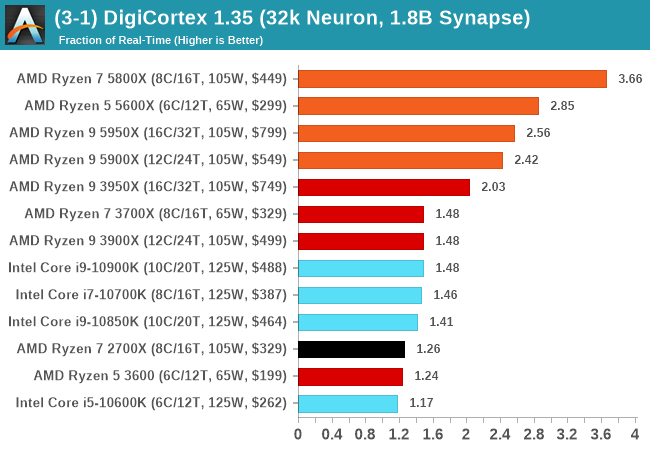
Dwarf Fortress 0.44.12: Link
Another long standing request for our benchmark suite has been Dwarf Fortress, a popular management/roguelike indie video game, first launched in 2006 and still being regularly updated today, aiming for a Steam launch sometime in the future.
Emulating the ASCII interfaces of old, this title is a rather complex beast, which can generate environments subject to millennia of rule, famous faces, peasants, and key historical figures and events. The further you get into the game, depending on the size of the world, the slower it becomes as it has to simulate more famous people, more world events, and the natural way that humanoid creatures take over an environment. Like some kind of virus.
For our test we’re using DFMark. DFMark is a benchmark built by vorsgren on the Bay12Forums that gives two different modes built on DFHack: world generation and embark. These tests can be configured, but range anywhere from 3 minutes to several hours. After analyzing the test, we ended up going for three different world generation sizes:
- Small, a 65x65 world with 250 years, 10 civilizations and 4 megabeasts
- Medium, a 127x127 world with 550 years, 10 civilizations and 4 megabeasts
- Large, a 257x257 world with 550 years, 40 civilizations and 10 megabeasts
DFMark outputs the time to run any given test, so this is what we use for the output. We loop the small test for as many times possible in 10 minutes, the medium test for as many times in 30 minutes, and the large test for as many times in an hour.
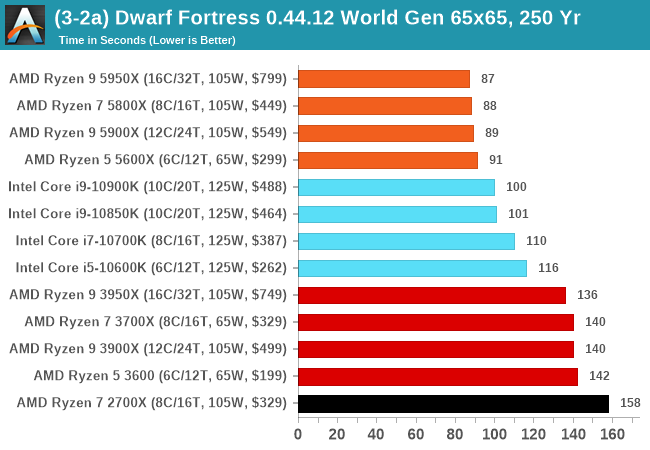
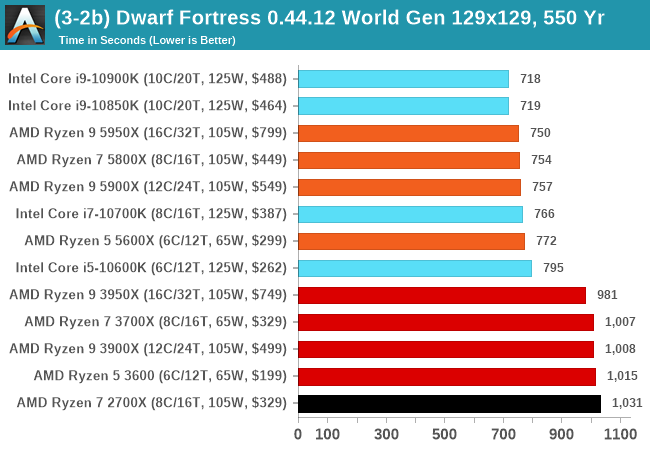
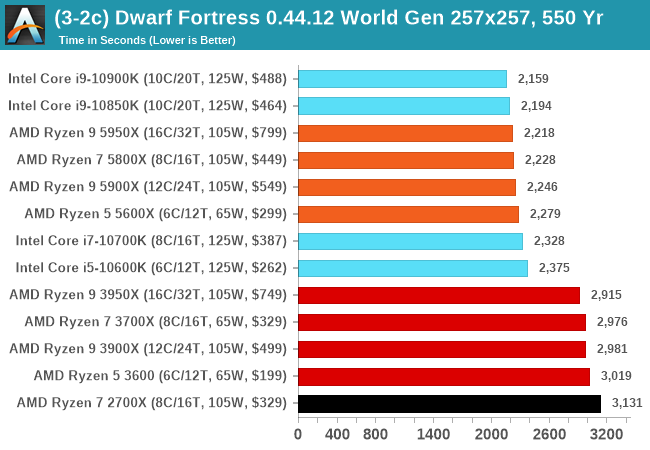
Dolphin v5.0 Emulation: Link
Many emulators are often bound by single thread CPU performance, and general reports tended to suggest that Haswell provided a significant boost to emulator performance. This benchmark runs a Wii program that ray traces a complex 3D scene inside the Dolphin Wii emulator. Performance on this benchmark is a good proxy of the speed of Dolphin CPU emulation, which is an intensive single core task using most aspects of a CPU. Results are given in seconds, where the Wii itself scores 1051 seconds.
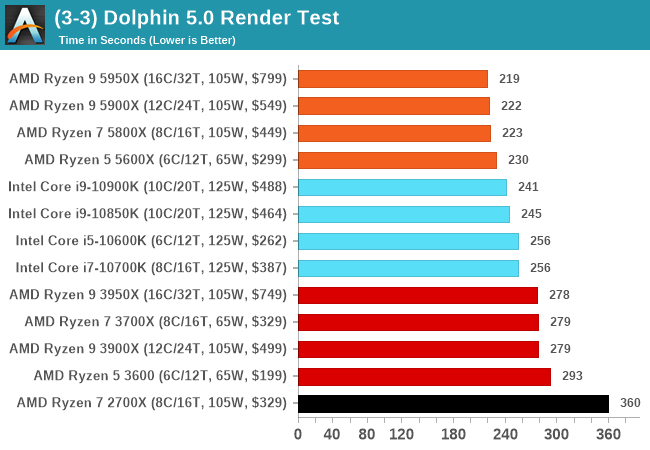












339 Comments
View All Comments
Hifihedgehog - Thursday, November 5, 2020 - link
Bloodbathgagegfg - Thursday, November 5, 2020 - link
Intel is preaching Moore's Law, AMD is executing it.FoRealz - Thursday, November 5, 2020 - link
Wow 5600x beating the 5900x in almost everything?Hul8 - Thursday, November 5, 2020 - link
Regarding "Why Does AMD Not Promote 5.0 GHz?":I'm sure AMD would rather talk to journalists about why some of their CPUs boosts +150MHz beyond the advertized boost frequency, and whether that's normal, than about many of the CPUs not reaching the advertized number... They learned that lesson.
haukionkannel - Friday, November 6, 2020 - link
Indeed! They did market last time that some golden samples will boost up to xxx... and the peoples reaction was really Angry! Now under advertising, ower delivering gives them perks instead, so yeah They Are learning!Because in the end, independent reviews will reveal the real speed eventually, so it does not hurt at all under advertise, because reviews will do all the advertisement amd needs!
Spunjji - Sunday, November 8, 2020 - link
100%poohbear - Thursday, November 5, 2020 - link
Doesn't like much of a difference between the mainstream 5800x and the 10700k. It'll boil down to price when choosing between them. TBH i'm a bit disappointed as i was expecting a trouncing of Intel by AMD, but now we see AMD is just matching Intel, which is great, but since the 5xxx AMD CPUs are matching Intel's in price, we haven't really reached new heights of performance or anything. But i guess the silver lining is competition is back, and now performance matters again.WaltC - Friday, November 6, 2020 - link
In some games, which is what I assume you are talking about since AMD walks away with almost all productivity software, AMD holds a lead of 30% +. Secondly, when game-engine optimization for Zen2/3 begins to mature and become widespread, AMD should walk away with most of it. It's interesting that in the titles where the most expensive Intel CPUs keep pace with the 5600X in terms of frame rates, the game engines were heavily optimized for Intel architectures.haukionkannel - Friday, November 6, 2020 - link
Well Intel did cut prices a lot to get even with amd, so amd has done its job in that part. Intel still have cpus that needs even more price cuts!But that is how market works. If Intel wants to compete with amd It has to do it with prices! And in the end it means you will get both companies products about the same price vs performance range! The point is that because of amd Intel has to compete with prices and as long as amd keep making these advancements Intel has to react and that means that there is competition and neither company can get too creedy! If one company has huge lead... it means higher prices. Now both companies has good products, the market will take of the prising!
duploxxx - Saturday, November 7, 2020 - link
you are smoking right?If you want better game performance you take the 5600X its faster everywhere vs 10700k and cheaper and on top very close performance on productivity not to mention way lower power consumption.
if you want more productivity and gaming you spend just a bit more and you get both. And still lower power consumption.
There are 0 reasons to buy an Intel cpu right now in this price range. THey will need to drop at least with 50-100$ to stay competitive. Not to mention there boards that lack PCIe-4.
lets see what smart memory does soon with ATI combo and there will even be less reasons to buy the Intel parts.